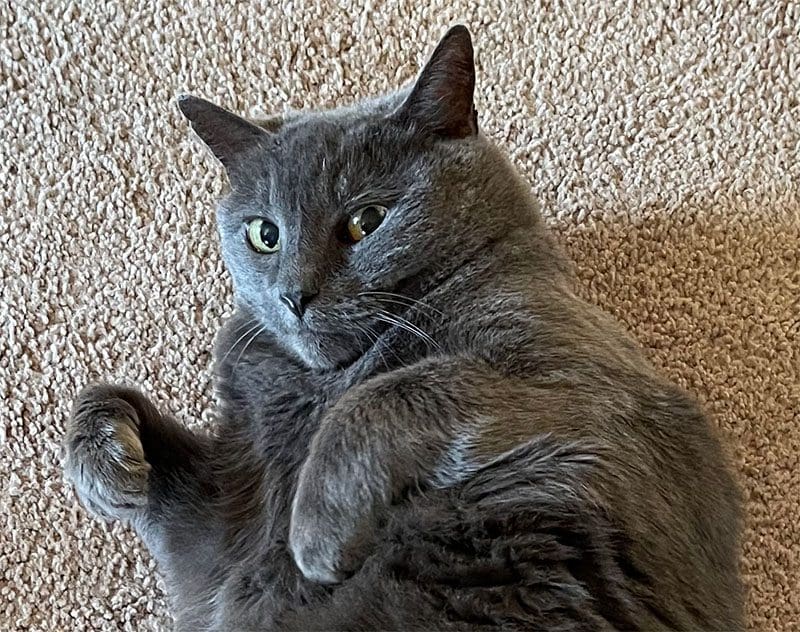
As a professional cat groomer, I am often asked what the best cat brush is.
So, I put together this article so that you can find healthy ways to brush your cat.
The good news is that there are several quality products and strategies for a variety of situations. Please read on to identify the best cat brush that will work for your cat.
In this Article We Cover:
- Why is it So Hard to Find the Best Cat Brush?
- The Best Cat Brushes: Products and Strategy
- Furminator Cat Brush: How Does it Affect Your Cat’s Fur?
- How Often Should I Brush My Cat?
- Why is it Difficult to Brush a Cat?
- Cat Coat Types: Should you Shave your Cat?
- Healthy Skin. Healthy Coat. Happy Cat!
Why is it So Hard to Find the Best Cat Brush?
Cats and their grooming needs can be a tricky subject. Even groomers will disagree on the best ways to deal with cat’s coats and their fickle personalities.
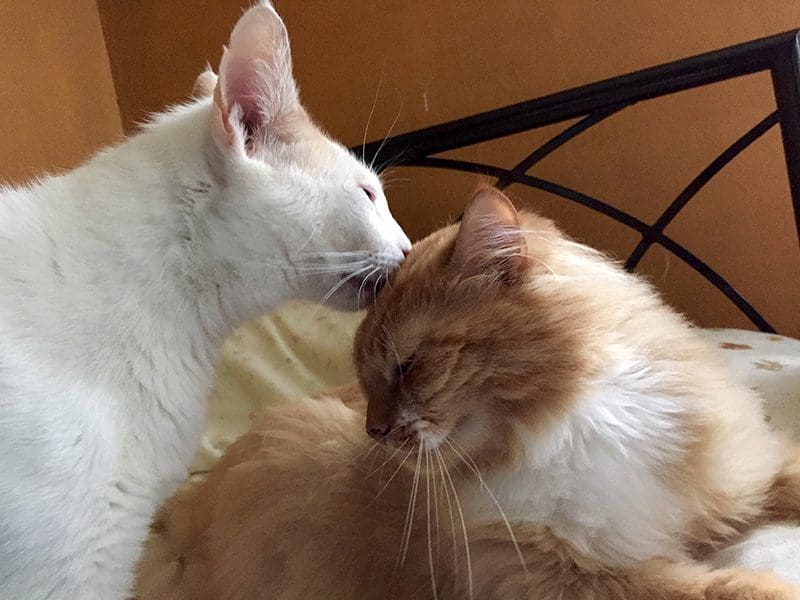
Cats groom themselves, after all … don’t they? Why would we need to mess with a self-cleaning creature, who may or may not welcome our attention?
The Best Cat Brushes are . . . Cat Combs!
After twenty years, countless hours, trial and error, and multiple classes in an attempt to find the perfect answer to all of our cat grooming woes, I’ve listed the best cat brushes, well … cat combs, actually, to keep our cats looking and feeling their best.
None of these can match what a skilled groomer can accomplish in the salon. A groomer will use high end products, a high velocity dryer, and great technique.
However, in between professional sessions, these cat brushes can help keep tangles and dead coat problems to a minimum.
Read on for my recommendations for the best cat brushes of 2023!
The Best Cat Brushes: Products and Strategy
My clients will often ask me what products I buy for my own pets. I signed up for the Amazon Associate Program so that I can include Amazon product links in this article.
If you click on a link below and make a purchase, I will receive a small commission at no extra cost to you. I truly appreciate this as it helps me to continue my mission to provide pet wellness education. Thank you so much!
Here is a listing of the best cat brushes, well, combs actually, I’ve found in 2023.
Cat Brushes to Get You Started
- Pixikko Mini Slicker Brush with Protective Tips
- Ryan’s Pet Supplies Paw Brothers Soft Pin Triangle Slicker Brush
To begin, you can flick away some of the debris and lift the coat a bit. This allows you to assess problem areas by working a Pixikko Mini Slicker Brush with Protective Tips through the coat.
You’ll want to work in sections, and make sure that you stop long before your cat seems annoyed. If you have an area of particular concern, start there, and plan to only work for about a minute. You can always pick up where you left off after you’ve both had a break.
The triangular head on the Ryan’s Pet Supplies Paw Brothers Soft Pin Triangle Slicker Brush can help you get into hard to reach areas.
The Best Cat Grooming Tool
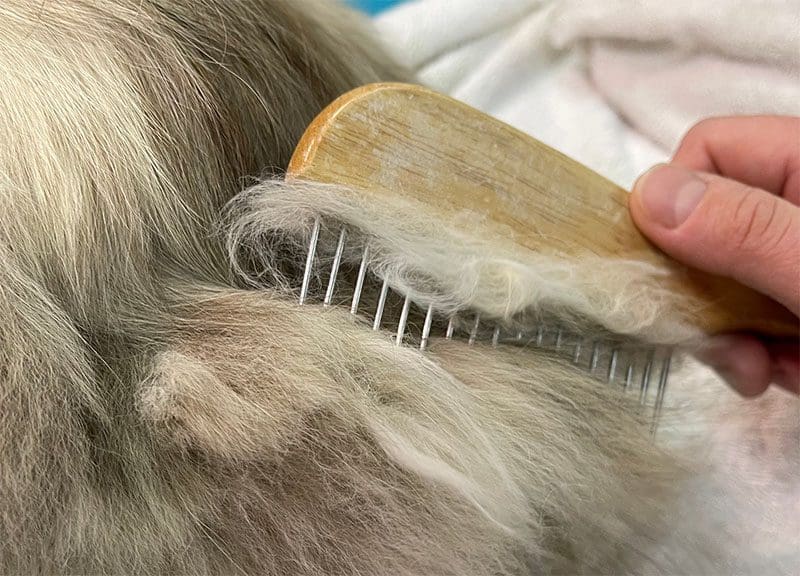
My favorite tool for cat brushing is the OmniPet Leather Brothers Cocker/Poodle Wooden Handle Comb.
The wide spaced teeth and long rounded pins are perfect for getting deep into the coat. This allows you to separate clumps of dead fur and scoop them out.
I will sometimes turn the comb on end to pick at a tangle if it’s small and not too tight. After this comb will pass through a cat’s coat, I’ll move onto the next step and use a comb with finer teeth.
Deshedding Tool for Cats
The Andis (Pet) 7-1/2-Inch Steel Comb is a real work horse in the grooming salon. You can use it in a similar fashion to the poodle comb, and also as a fine-tuning comb.
For cats, this comb is a great middle step to check for mats. It will also lift the dead coat which then allows the dryers to blow it away.
I use a circular or scooping motion as I comb in sections to loosen all of the dead coat.
Long Hair Cat Brush
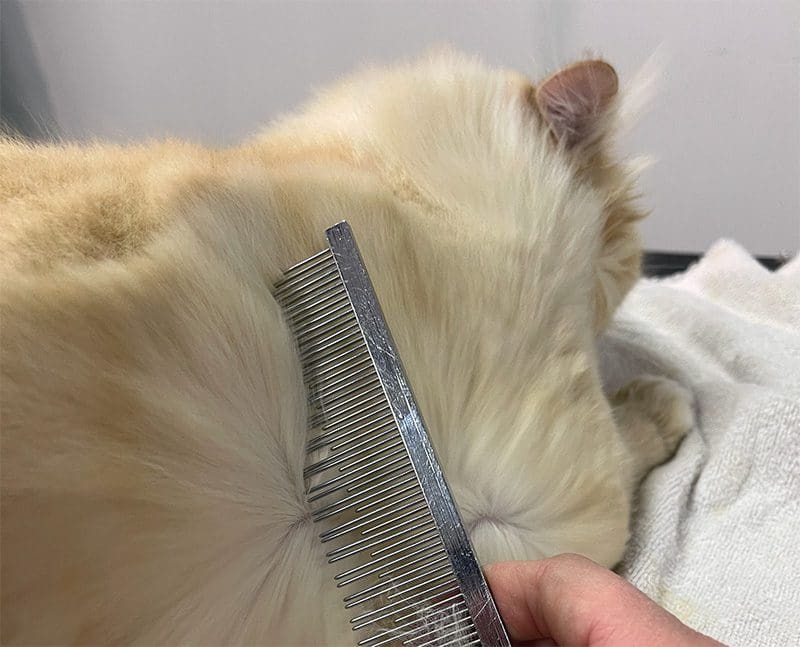
To really get deep into the coat, I like the Detangling Pet Comb with Long & Short Stainless Steel Teeth as a final step. I’ll comb through the whole coat again and make sure every hair is separate. This provides good airflow to the skin.
Long Hair and Short Hair Cat Brush
For faces, legs, and cheeks, I always keep handy the Stainless Steel Teeth Cat and Dog Pet Grooming Comb. It has narrowly spaced teeth which is perfect for brushing these areas.
Working on these areas frequently is easier than letting them go for long periods of time. The coat can become very dense and it can be tricky to work it loose.
Cats especially seem to enjoy when you comb their faces. So, this is a great place to start and end your grooming sessions.
Beyond Cat Brushes
A proper bath and dry by a groomer is best. But, in between you’ll want to use a waterless bath such as Nature’s Specialties Waterless Shampoo Plum Silky
It’s gentle and tearless. Use it on a damp cloth to wipe dirt, pollution, and excess skin oils from the surface of the cat’s coat.
A terry cloth like the Bone Dry Towel makes a perfect pet wipe. This allows you to remove grime so you don’t wind up brushing it further into the cat’s coat and skin. This is also a good way to reduce static which can cause the dead coat to resist your efforts.
You can use a small washcloth or tissue to clean your cat’s face and the chin. These areas are often crusty and can add to irritation and skin infections.
Practice Makes Perfect: Just Ask Your Cat!
You should practice handling your cat gently. It also helps to give them lots of treats or a food they love while you brush them.
I like to apply a conditioning spray or even plain water to the cat’s coat. I use my hands or a small towel for the application. Cats will often take offense if you spray them directly.
Eqyss Avocado Mist Pet Conditioner used lightly as you work will smooth damaged hair and minimize static and tangles.
Cat Brushing Tips

If your cat’s coat has mats, ask a professional groomer to clean him up before you brush him. You don’t want to pull and irritate his skin.
I like to use the analogy of two phone books with interlaced pages. The friction of so many pages makes it almost impossible to pull them apart, even when tied to the bumpers of two vehicles going in opposite directions.
The dead coat in your cat’s fur can become glued in place by dirty skin oils and thousands of other hairs holding onto it. If you try to tear the dead coat from your cat’s skin, something will have to give … and it’s likely to be the cat’s skin.
When to Take Your Cat to the Groomer
If your cat’s coat is in rough shape, please don’t put them through a marathon brushing session. Allow a groomer to clean and condition the skin and coat, and then blow away the hair using their dryer and good technique.
If you discover any skin issues or your cat seems irritated or uncomfortable, you should consult your vet before proceeding with any grooming routine. After the vet says your cat is healthy, you can ask a force-free trainer or cat groomer to teach you how to introduce your cat to brushing without making them more afraid or uncomfortable.
Always brush your cat in the direction the coat grows to prevent damaging the delicate structures of the skin. If you encounter mats, or tangles, stop brushing that area. Ask a professional groomer to assist you with those areas.
Cats Can Be Injured Accidentally
Many cats are injured accidentally by well-meaning owners who try to cut matted fur or hair. Have the tangles shaved out safely by a groomer first. Then, you can continue your brushing routine more regularly to prevent the tangles from happening again.
Always stop before your cat seems grumpy or tired of your session. Remember to keep your grooming sessions happy, and full of tasty treats. This encourages your cat to participate and not just tolerate what you need to accomplish.
Be careful not to train your cat that grumpiness will end a session. However, do not use punishment to stop your pet from showing when they aren’t happy. Instead, stop your session, and seek out a reward-based trainer who uses science-backed methods to show you how to improve your pet’s experience with grooming.
Furminator Cat Brush: How Does it Affect Your Cat’s Fur?
The Furminator Cat Brush is a very popular and well marketed brush that clients will often ask me about. However, it is notorious for shredding your cat’s top coat while not removing the dead undercoat.
The Furminator was originally designed around what is called a carding tool. Carding tools require a careful, trained technique. The Furminator does not allow for the proper angle or technique to be used to avoid damaging the coat.
Lots of Fur Removal Can Be Bad
The pile of fur resulting from the use of the Furminator is from cutting healthy and dead coat alike instead of properly pulling dead coat from the root.
It’s best to use quality deshedding tools and techniques. It’s also important to establish a routine with a knowledgeable groomer for healthy skin and to control shedding.
How Often Should I Brush My Cat?
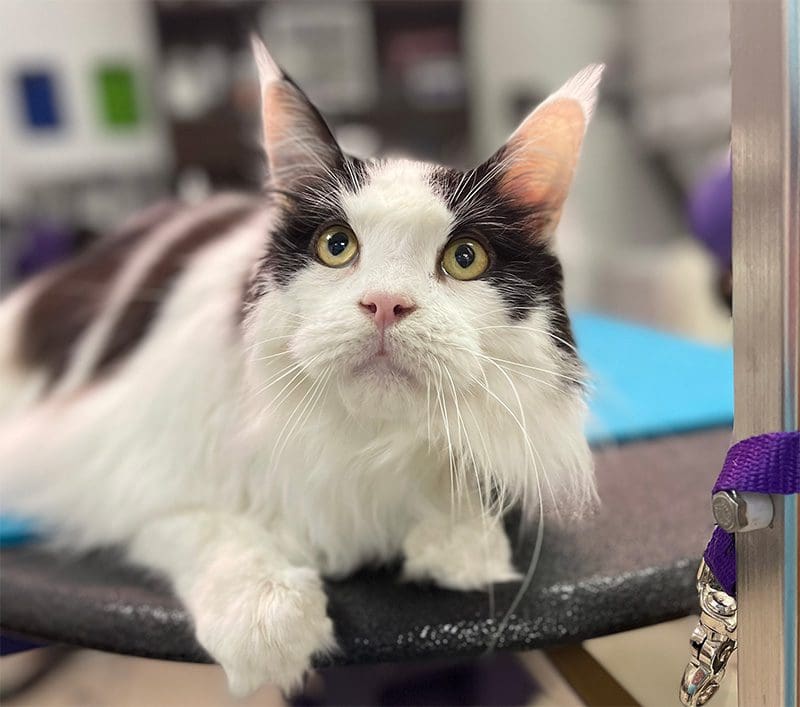
If possible, it’s great to connect with a local cat groomer for professional assistance to keep your cat’s coat clean and free of built up dead hair. There is no substitute for the gentle, but thorough dead hair removal that a deshedding bath and drying can provide to your cat.
Brushing and combing is really best to help manage the coat in between full grooming sessions that should occur every other month at a minimum.
As long as your cat isn’t showing any signs of distress or discomfort, you can brush your cat as often as once per day for 5 to 10 minutes.
Why is it Difficult to Brush a Cat?
Not only is it difficult to find an effective tool for the job, a common complaint I hear as a cat groomer is: “My cat HATES being brushed!”
A cat’s skin is extremely delicate and sensitive. It is so thin that anything applied to their skin can be absorbed into the bloodstream within seconds, and they will actually taste products applied to their skin.
A cat’s coat is an important buffer and protection against all kinds of irritants and damage, and it’s far denser than the average dog’s coat, sometimes having 30 hairs per follicle.
Raking a wire or plastic brush over the surface doesn’t get to the literal root of the problem. This can damage the hair, cause over-production of oil, and create irritating sensations for your cat.
You could also create a buildup of static which can increase fraying and tangling of the cat’s coat. This can exacerbate any matting or deep tangles and require professional attention to correct.
Long or short hair, it is actually the density and the texture of the coat that causes us to rip our own hair out in frustration.
A Health Issue Can Impact Your Cat’s Fur
All of this is an issue if the cat is healthy. Add to that: an aged cat, or one who has underlying health issues and it can be even more difficult to keep the cat’s coat and skin in healthy condition.
Fur is nature’s design. The outer layer is shiny and repels dirt, UV rays, water, and damage. The inner layer is insulating and provides loft around the body. The outer and inner layer, topcoat and undercoat, both shed, but the topcoat sheds much less.
The undercoat is responsible for much of the hair we see on our clothes and furniture. It is because of this dual coat, that a brush can’t get deep into the coat to lift out the dead coat while not overly raking the protective topcoat.
Cat Coat Types: Should you Shave your Cat?
The most common request I get as cat groomer is, “I think he/she just needs to be shaved in one of those lioncuts”.
All cats have double coats, except for the Rex and Sphinx breeds. That means most of them, unless they are hairless, possess a topcoat and an insulating undercoat.
All cats, including the hairless breeds are classified as furred animals, as opposed to haired animals like you see in some dog breeds, such as the poodle or Maltese.
Haired animals have coats made of hair that keeps growing and can receive haircuts without damaging the structure of the coat.
Long Haired Cats and Short Haired Cats
Long haired cats, such as the Persian cat, and short haired cats, such as a Siamese, both have double coats.
The coat grows to a predetermined length, then it dies, sheds and regrows again to that predetermined length. Selective breeding gave us all the different length, textures, and colors, but they are all double coated.
Sometimes it is necessary to shave a cat. If your cat’s coat has too many tangles or matts, it may be beyond salvaging . An underlying health or behavior issue can make less-drastic grooming measures, such as regular de-shed baths and drying, unrealistic.
Shaving cats, however, does leave their skin exposed to the environment. If done regularly, this can cause the cat’s skin to adjust by thickening the undercoat and oils.
Additionally, the top layers of skin may thicken to protect the underlayers from environmental stressors such as dryness, temperature, UV light, and irritants (including cleaning products and dust from cat litters). This is not good for your cat’s health.
Removing just the built up oils and dead undercoat gently and on a consistent basis, I have discovered, is far more helpful, comfortable, and appropriate in almost every case.
Proper bathing and conditioning is required for the dead coat to be rinsed and then blown out with the dryer with no additional damage to the coat or skin. Even cats who have never experienced a bath before, which is most cats who come to my salon, can adjust to gentle bathing and drying.
The hair growth cycle is about a month for a cat, so a bath at least every 4 to 8 weeks is needed to keep a well maintained coat. This also keeps the buildup of dead coat at a manageable level before it starts to cause issues.
When it’s Time for a Lioncut
Of course, there are cases where a cat is too defensive or the coat is too damaged to save, and then the clean slate of a “lioncut” can set them right. After that, it’s important to start a professional grooming routine that you can help along with some care at home.
A note on hairless breeds: You’ll often hear that they require regular bathing to curb their excessive oiliness. The body must have a protective layer over the skin and if fur isn’t an option, oil will become thicker and more viscous to compensate. Degreasing cats, hairless or not, will cause excessive dryness and irritation to their skin.
Shaving cats who normally have fur will cause excessive oiliness, which then gums up the newly growing hair, causing a vicious cycle of matting and poor coat quality. This leads to a cat who must be continually shaved to stay comfortable.
It takes years for a cat’s topcoat to regrow compared to several weeks for the undercoat. So, the cat is left with a cottony, over-thick undercoat and no topcoat to keep debris from irritating the cat’s skin.
Healthy Skin. Healthy Coat. Happy Cat!
Shaving coats short is not a substitute for proper coat care. Cats are double coated, just like a Husky or a German Shepherd, and shaving them results in impairment to the skin’s oil distribution mechanisms, and an over-exposure of the skin to the environment.
Only in extreme cases, where a cat can’t be comfortably maintained with regular maintenance brushing, bathing, or spot-shaving should full-body shaving be considered appropriate. Breeds of cat, such as the Persian and Himalayan are among the most labor-intensive and costly I groom.
Study Up on Cat Breeds
I recommend thoroughly researching any breed of cat you might bring home to be sure it is the right fit for your family, finances, and routine.
A healthy coat will give your cat protection from the sun and extreme temperatures and also provide a buffer from environmental stressors. Keeping the coat clean and well-maintained will ensure your pet is able to stay cool in the summer and warm in the winter. Shaving isn’t necessary or recommended for cats to feel cooler.
If possible, it’s great to connect with a local cat groomer for professional assistance to keep your cat’s coat clean and free of built up dead hair. There is no substitute for the gentle, but thorough dead hair removal that a deshedding bath and drying can provide to your cat.
Brushing and Combing Your Cat
Brushing and combing is really best to help manage the coat in between full grooming sessions that should occur every other month at a minimum.
Some short haired breeds of cat can be maintained with a bath and dry once a season, but the routine of bathing should be kept up to minimize the effort required from your groomer as well as the stress on your cat.
There are cats who may never see a groomer and do just fine. However, I feel it’s a good idea to prepare pets in case they can’t keep themselves as tidy as they age or they develop health conditions where they need help to stay clean and comfortable.
I hope you found this guide helpful and that you are ready to find the best cat brush for your cat! Here’s to many enjoyable grooming sessions in your future!
Ready for More Cat Articles?
Please check out our Cat Blog for a full listing of all of our cat articles!
Join Our Mailing List!
We hope you enjoyed reading this article! The Absolute Animal Care Blog features articles that contain our best recommendations for dog and cat wellness, training strategies, and products.
Please join our mailing list to receive updates when new articles are released!
